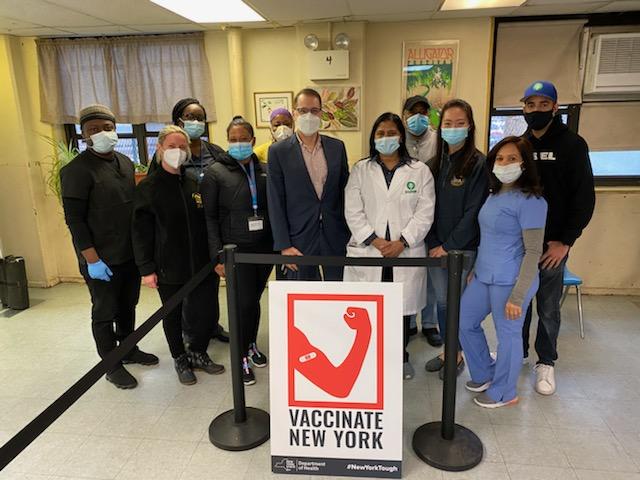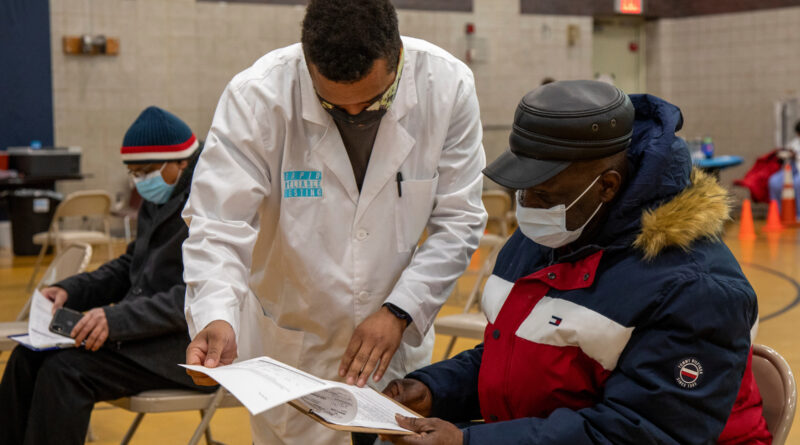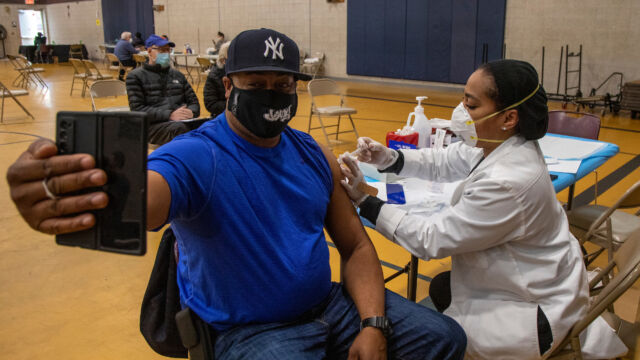NYCHA Brings Vaccination Sites to Residents
In mid-January, New Yorkers 65 and older became eligible to receive the COVID-19 vaccine. NYCHA’s population includes a large number of older adults, and the City and State established vaccine clinics at certain NYCHA developments to ensure that the vaccine was accessible to these residents. As more people became eligible, the clinics at NYCHA locations continued to provide residents with the vaccine close to home.
Setting up and hosting these clinics is a major undertaking that could not be accomplished without NYCHA staff, community and senior center operators, volunteers, and health partners. Both the City and State rely on NYCHA for critical assistance; the team leading these efforts at NYCHA is Lauren Gray, NYCHA’s Vice President of Compliance; Ukah Busgith, Senior Director of Family Partnerships and Acting Vice President of Community Engagement and Partnerships; and Marina Oteiza, Social Services Administrator for Family Partnerships, all members of NYCHA’s COVID-19 Taskforce.
“NYCHA has taken on the huge role and responsibility to ensure that the COVID-19 vaccine is accessible to our residents,” said Ms. Gray. “We’ve worked a lot of long hours, and the hard work and dedication that so many people have put in in the last four months is inspiring.”
In January, NYCHA’s first priority was to identify senior centers in neighborhoods with high COVID-19 positivity rates and do walk-throughs of the facilities to determine if sites were suitable to host a vaccine clinic. After the locations and dates were selected, it was time to get the word out to residents. NYCHA staff on the ground posted flyers and knocked on doors to inform residents, robocalls were sent to eligible residents, and staff made thousands of calls to register seniors for vaccine appointments.
From the launch of the NYCHA vaccination sites to now, the team has relied on a network of NYCHA employee volunteers to assist with crowd control, answer questions, and enforce social distancing and mask requirements – that volunteer network has grown to approximately 150 NYCHA staff. “We could not have made this program successful if we didn’t have all these people wanting to help,” said Ms. Gray. “We have this pool of volunteers that we can call every week to make phone calls and manage vaccine sites. Volunteers had no guarantee of being vaccinated – at the end of the day, people just want to help.”

After successfully launching the initial sites and vaccinating many NYCHA seniors, the City contacted NYCHA to figure out how to continue and expand the vaccination efforts. The team worked to create a sustainable model for vaccine distribution at NYCHA developments. The team identified clusters of NYCHA developments located near each other to determine how many NYCHA residents could be reached with a central vaccine clinic. The team also had to factor in the mobility of older adults, making sure sites were a mile away or less, were walker friendly, and were close to public transportation.
The team identified 11 hub sites throughout the city that could host vaccine distribution for several months as a central location for NYCHA residents and the entire community. For instance, Johnson Community Center could serve residents of Johnson Houses as well as those at 20 additional developments in or around East Harlem. When launching sites that serve a number of developments, the team relied on the assistance of NYC Test & Trace canvassers to conduct outreach at all of the developments close to Johnson Houses; the canvassers were armed with iPads to help register residents for a vaccine appointment on the spot.
The 11 hub sites are located at community and senior centers at Castle Hill, Forest, and Mitchel Houses in the Bronx; Van Dyke I, Roosevelt II, and Carey Gardens Houses in Brooklyn; Johnson, Gompers, Saint Nicholas, and Rutgers Houses in Manhattan; and Queensbridge North Houses in Queens.
“Our community-based organization partners that operate community and senior centers were instrumental in this work,” Ms. Oteiza said. “A lot of them had to reopen their doors and make a shift in services – they’ve been very accommodating.”
Ms. Busgith added, “Our resident association leaders were also instrumental in helping to get the word out to residents and volunteering at the vaccine sites.”
In addition to the hubs, there will be 30 pop-up clinics (which will run between 1 to 4 weeks) and 26 standalone sites (which will run between 1 day to 3 weeks).
Now that a sustainable model for vaccine distribution at NYCHA locations has been established, the team hopes that these clinics will provide an accessible and stabilizing force for NYCHA residents and their communities.





